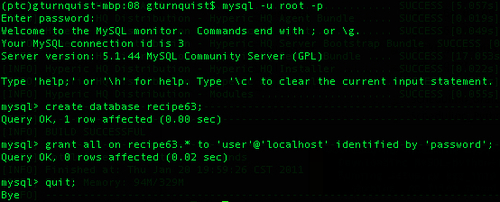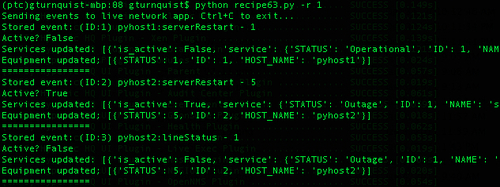Coding a simulator that spits out data at a defined rate can help simulate real load.
This recipe assumes that the reader's machine is installed with MySQL.
- Make sure the MySQL production database server is up and running.
- Open a command line MySQL client shell as the root user.
- Create a database for this recipe called
recipe63as well as a user with permission to access it. - Exit the shell.

With these steps, we will explore coding a test simulator:
- Create a test generator script called
recipe63.pythat uses various Python libraries.import getopt import random import sys import time from network import * from springpython.remoting.pyro import *
- Create a usage method that prints out command-line options.
def usage(): print "Usage" print "=====" print "-h, --help read this help" print "-r, --rate [arg] number of events per second" print "-d, --demo demo by printing events" - Use Python's
getoptlibrary to parse command-line arguments.try: opts, args = getopt.getopt(sys.argv[1:], "hr:d", ["help", "rate=", "demo"]) except getopt.GetoptError, err: print str(err) usage() sys.exit(1) rate = 10 demo_mode = False for o, a in opts: if o in ("-h", "--help"): usage() sys.exit(1) elif o in ("-r", "--rate"): rate = a elif o in ("-d", "--demo"): demo_mode = True - Add a switch so when NOT in demo mode, it uses Spring Python's
PyroProxyFactoryto connect to a server instance of the network management application defined in Chapter 7, Building a network management application.if not demo_mode: print "Sending events to live network app. Ctrl+C to exit..." proxy = PyroProxyFactory() proxy.service_url = "PYROLOC://127.0.0.1:7766/network" - Code an infinite loop that creates a random event.
while True: hostname = random.choice(["pyhost1","pyhost2","pyhost3"]) condition = random.choice(["serverRestart", "lineStatus"]) severity = random.choice([1,5]) evt = Event(hostname, condition, severity) - If in demo mode, print out the event.
if demo_mode: now = time.strftime("%a, %d %b %Y %H:%M:%S +0000", time.localtime()) print "%s: Sending out %s" % (now, evt) - If not in demo mode, make a remote call through the proxy to the network app's process method.
else: stored_event, is_active, updated_services, updated_equipment = proxy.process(evt) print "Stored event: %s" % stored_event print "Active? %s" % is_active print "Services updated: %s" % updated_services print "Equipment updated; %s" % updated_equipment print "================" - Sleep a certain amount of time before repeating the loop.
time.sleep(1.0/float(rate))
- Run the generator script. In the following screenshot, notice there is an error because we haven't started the server process yet. This can also happen if the client and server have mismatched URLs.

- Create a server script called
recipe63_server.pythat will run our network management app connected to MySQL using SQL scriptrecipe62_network.sqlfrom Targeting the test server.from springpython.database.factory import * from springpython.database.core import * from springpython.remoting.pyro import * from network import * import logging logger = logging.getLogger("springpython") loggingLevel = logging.DEBUG logger.setLevel(loggingLevel) ch = logging.StreamHandler() ch.setLevel(loggingLevel) formatter = logging.Formatter("%(asctime)s - %(name)s - %(levelname)s - %(message)s") ch.setFormatter(formatter) logger.addHandler(ch) # Initialize the database factory = MySQLConnectionFactory("user", "password", "localhost", "recipe63") dt = DatabaseTemplate(factory) sql = open("recipe62_network.mysql").read().split(";") for statement in sql: dt.execute(statement + ";")
- Add code to expose the app using Pyro.
# Create an instance of the network management app target_service = EventCorrelator(factory) # Expose the network app as a Pyro service exporter = PyroServiceExporter() exporter.service_name = "network" exporter.service = target_service exporter.after_properties_set()
- Run the server script in a different shell.

- The default rate is 10 events/second. Run the generator script with a rate of one event/second. In the following screenshot, notice how the script generated a clear, fault, and then another fault. The service started at Operational, moved to Outage, and stayed there.

Python's random.choice method makes it easy to create a range of random events. By using the time.sleep method, we can control the rate at which the events are created.
We used Pyro to connect the test generator to the network management application. This isn't the only way to connect things together. We could have exposed the application through other means, such as REST, JSON, or perhaps by communicating through a database table. That's not important. What is important is that we built an independent tool that fed data into our application as if it came from a live network.
We built a test generator. It's easy to run multiple copies of it in different shells, at different rates. We have an easy way to simulate different subnets producing different volumes of traffic.
We could also add more command-line options to fine tune the events. For example, we could make the event condition a parameter, and emulate different rates for different types of events.
A production version of the server wouldn't do this. For demonstration purposes of this recipe, it is convenient to put it there. Every time we stop and start the server script, it relaunches the database.
- Targeting the test server
- Chapter 7, Building a network management application
